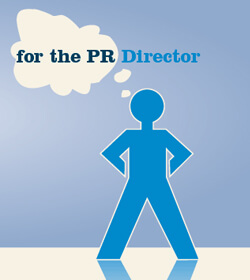 This past summer, I presented a webinar about Marketing in the Round, the book written by Geoff Livingston and me.
This past summer, I presented a webinar about Marketing in the Round, the book written by Geoff Livingston and me.
Maddie Grant, the co-founder of SocialFish and host of the webinar, asked me to keep the presentation to about 35 minutes so there was plenty of time for attendees to ask questions.
And questions there were!
There were so many questions, we thought answering some of them would make a good blog post. But then that one blog post turned into three.
So I cherry picked what I thought were the most applicable questions for the Spin Sucks readers and have answered them here for you. Even if you haven’t read the book or seen Geoff or me speak on the topic, I think these still work for you.
How do you prioritize budgeting if you’re starting something completely new–such as digital marketing, SEO, or social media?
You know, I hate to use “it depends” as an answer, but it really does depend. The nice thing with the digital tools – particularly social media – is they are free. Now, don’t get me wrong. The time involved in using those tools is not free, but you have the opportunity to test some things without spending a bunch of time or money.
My best advice is to create a listening program. You can do this with tools such as Google alerts and Social Mention.
What percentage of the budget should be experimental?
Gosh. I don’t know if I’d say there is a percentage of your budget that should be experimental. Rather, I’d make it part of someone’s job. For instance, maybe they spend an hour a day (or half an hour) looking at new tools, reading the reviews and blog posts, and determining whether or not it’s something you should invest time in learning more about.
It’s pretty easy to tell, within a year of a new product/tool launching, whether or not you should experiment with it. For instance, I’d recommend all organizations use Google+ just for search engine optimization purposes. Google looks very kindly on returning search results for the content that is shared through Google+. But if you’d asked me a year ago, when the tool came out, I would have guessed it’d have been more of a social network.
So I’d say allot some time each day to learning more about what’s out there, but let things settle before you decide whether or not you should integrate something new into your overall program.
What skills do you need to have on the team vs. skills you can outsource?
I believe pretty strongly that your audiences, customers, stakeholders, and employees want to have a conversation with you online, not some PR or marketing professional who doesn’t work inside your organization. That said, there are many things an outsourced professional or agency can do to free up your time to allow your internal team to have the conversations. Things such as strategy development, creation of an editorial calendar, scheduling of updates, monitoring the conversations, finding news and links of interest, and coaching. But your internal team should have the authority to not only have online conversations, but be able to make decisions that will create a happy customer.
What these tools do is allow you to monitor what’s being said about the industry, your competition, and even you online. Once you figure out where people are spending their time online, focus your energies there first. Don’t try to be all things to all people or jump on every new tool. Once you figure out whether or not there is an opportunity, then you can figure out how much time and money to invest in doing it right.
What are some common metrics that work across an entire marketing department?
I come from the for-profit world, so the metrics we consider for every client are: Increased revenues, improved margins, and/or a shortened sales cycle. In a non-profit or membership-based organization, you could consider increased funding, larger donations, or more members. These are the types of things that will allow you to measure a return-on-investment that is music to the executive team’s ears.
What say you?
A very modified version of this ran on the SocialFish blog. If you want to read the entire three-part series and all of the Q&A, part one is here, part two is here, and part three is here.